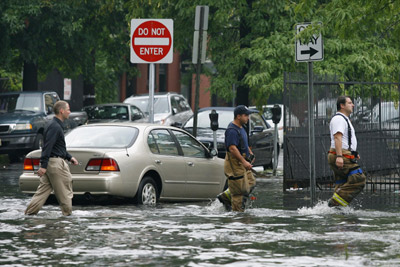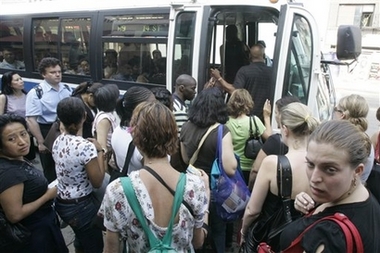Rain cripples New York City transit
Updated: 2007-08-09 09:47
 Firemen and a resident walk through a flooded street in Hoboken, New Jersey after early morning thunderstorms caused damage throughout the New York area August 8, 2007. [Reuters] |
NEW YORK - A torrential downpour sent water surging through New York's subway system and highway tunnels and across airport runways Wednesday, leaving thousands of commuters stranded and one big question: How could 3 inches of rain bring the nation's largest mass transit system to a halt?
The storm, which also spawned a rare tornado, hit just before dawn. By rush hour, the subway system was virtually paralyzed when pumping stations became overwhelmed. Bedlam resulted from too much rain, too fast; some suburban commuters spent a half day just getting to work.
"One big rain and it all falls apart," said Ruby Russel, 64, as she sat waiting on a train in Brooklyn. She had been trying to get to Manhattan for three hours.
The failure renewed a debate about whether the network of pumps, sewers and drains that protects the city's subways from flooding needs an overhaul. Every line experienced some sort of delay as track beds turned into streams gurgling with millions of gallons of rainwater. The washout was the third time in seven months that the subways were disrupted by rain.
Metropolitan Transit Authority engineers were asked to report back to Gov. Eliot Spitzer within 30 days with suggestions about how to deal with the chronic flooding.
"We have a design issue that we need to think about," Spitzer said.
The National Weather Service said a tropical air mass dumped an extraordinary amount of rain in a short period of time. The worst was recorded between 5 a.m. and 8 a.m., with 2.5 inches falling on Central Park and almost 3.5 on Kennedy International Airport.
 Commuters pack into a bus on the Lower East Side of Manhatan Wednesday, Aug. 8, 2007 in New York. Heavy rains dumped two and a half to three inches of rain on the city overnight, flooding tracks and roadways. [AP] |
Naturally, the stormwater sought the low ground, and that meant the subways. Water poured in through vents, drowned the signal system and flooded the third rail, forcing a shutoff of power on some lines.
MTA Executive Director Elliot G. Sander said the intensity of the rain was simply overwhelming. The subway's drainage system can generally handle a maximum of 1.5 inches of rainfall per hour.
"The timing and intensity of the storm took us by surprise," Sander said.
The subway problems come as weather experts predict New York is due for a major hurricane. A storm with 130 mph winds and a 30-foot storm surge could cause the Hudson and East rivers to overflow — and bring with it more significant flooding than a severe rainstorm.
Keeping the subway system dry is a challenge, even in regular weather.
On an average day, hundreds of MTA pumps remove 13 million gallons of water from the system, which includes several tunnels and stations below sea level. Much of that water is groundwater that enters from sources such as streams.
Public officials called for improvements in the drainage system after a similar rain-related shutdown in 1999, and the MTA made some changes after another round of paralyzing tunnel floods in 2004, when the remnants of Hurricane Frances washed out the subways for hours.
The city's sewer and stormwater drains can handle steady rain, "but when it comes to these very intense, high inch-count rain events, over a short period of time, it is very difficult," said Michael Saucier, a spokesman for the city's Department of Environmental Protection.
DEP Commissioner Emily Lloyd said the city is spending $300 million per year upgrading its piping systems and has been gradually building a more robust stormwater drainage system to replace the old combined sewers that handled wastewater and rain.
In Manhattan, Times Square was one huge mess Wednesday, packed with many of the 4 million riders who rely on the subway system daily. Thousands waited for hours for any means of transportation, jostling one another to get on the few buses that arrived. The suburbs were no better: In Westchester County, hundreds of commuters were stopped on a Metro-North train due to track flooding.
Streams of people in business attire — with briefcases, cell phones and BlackBerries in hand — trudged through drenched streets toward the subway. But it, too, was flooded. The hordes then made a beeline for buses they'd spotted up the street.
The storms also created problems for the region's airports, where delays of up to an hour were reported. The National Weather Service said a tornado touched down in Brooklyn, where winds downed trees, tore off rooftops and wrapped signs around posts. At least 40 homes were damaged.
Tornadoes have hit New York City before, but not often. The National Weather Service had records of at least five, plus sketchy detail on the last reported tornado sighting in Brooklyn, in 1889. None was as strong as Wednesday's twister, which had winds as high as 135 mph.
"It's a once-in-a-lifetime event," said Jeffrey Tongue, a Weather Service meteorologist.
A woman on Staten Island died when a car got stuck in an underpass and another car came along and hit hers, Mayor Michael Bloomberg said. A handful of people were injured, Bloomberg said.
Lanie Mastellone, who lives in Brooklyn's Bay Ridge neighborhood, awoke as her roof was coming off. Before escaping, she ran to get her late husband's wedding ring.
"It happened so quick. Maybe he was watching over me," Mastellone said.
At the end of the day, some trains were finally back up and running. But commuters trying to get home were met with another unpleasant surprise: The storm left behind high humidity that felt like they were walking into a sauna — and when they got onto train cars, a sardine can.
|
|
|
||
|
||
|
|
|
|